[转] 如何应用设计模式设计你的足球引擎(三和四)----Design Football Game(Part III and IV)
原文地址:http://www.codeproject.com/KB/cpp/applyingpatterns2.aspx
译者:赖勇浩(http://blog.csdn.net/lanphaday )
解决方案架构师:你的进度怎么样?
愚蠢的开发者:是的,我觉得我学会了如何应用 Observer 模式去解决所有问题
解决方案架构师:一个模式解决所有问题?
愚蠢的开发者:啊,还不够么?
介绍
关于本文
本文是这个系列的第二篇文章,在阅读本文之前,你应该已经读过并且理解这个系列的第一篇,题为
- 学习如何应用设计模式设计你的足球引擎(第一、二部分)
在第一篇文章中,我们讨论了
- 什么是模式,如何使用它们
- 如何支持方案应用模式
- 如何用观察者模式来解决我们的足球引擎的设计问题
本文是前一篇文章的延续,在这里我们将讨论
- 第三部分:应用 Strategy 模式解决“球队(Team)”和“球队策略(TeamStrategy)”相关的设计问题
- 第四部分:应用 Decorator 模式来解决“球员(Player)”相关的设计问题
如果你已经不记得这些设计问题,最好翻回第一篇文章去看看再回来继续。
第三部分
Strategy 模式
在这一节我们将深入策略模式,然后我们应用这个模式来解决第二个设计问题。像前一篇文章那样,在这里我们再来回顾一下我们的第二个设计问题。
如何你能够记起,我们的第二个设计问题是:
- 特定的设计问题:在比赛进行时,终端用户能够改变它的球队的策略(如从进攻改为防守)
- 问题泛化:需要客户端(在这里就是球队)使用的算法(球队策略)能够独立改变
如前文所言,当比赛进行时,我们需要改变球队的策略(如从进攻改为防守)。确切来说就是需要从球队分享球队的策略。
我们已知可以利用策略模式来解决上述设计问题,因为它可使客户端(例如球队)使用的算法(例如球队策略)能够独立改变;那么我们来看看如何利用 Strategy 模式来解决这个设计问题。
理解 Strategy 模式
Strategy 模式非常简单,下面是 Strategy 模式的 UML 图:
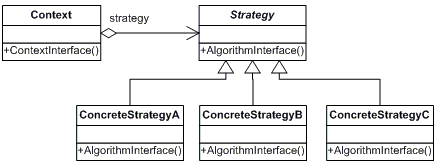
Fig - Strategy Pattern
它包括如何几个部分
- 策略(Strategy)
这是一个算法(策略)的抽象类,所有的具体的算法都派生自它。简单地说,它为所有的具体算法(或具体的策略)提供了一个通用的接口。换言之,如果类 Strategy 有个抽象函数叫 foo(),那么所有具体的策略类都应该重载foo() 函数。
- 具体的策略(ConcreteStrategy)
这个类是我们真正实现算法的地方,或者说,它是类 Strategy 的具体实现。例如 Sort 是实现算法的策略类,而具体的策略可以是 MergeSort 或 QuickSort 等等。
- 上下文(Context)
Context可由一个或多个策略类配置,它通常策略接口访问具体策略对象。
应用 Strategy 模式
现在让我们想想如何用 Strategy 模式来解决问题。
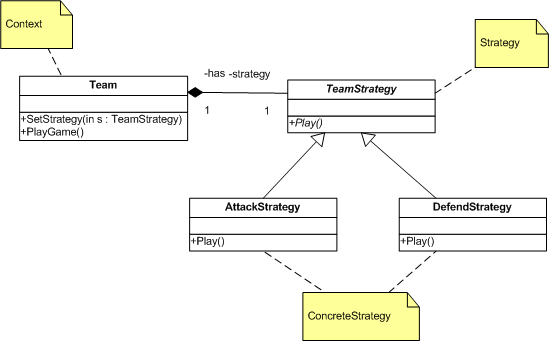
Fig - Solving Our Second Design Problem
类 TeamStrategy 包含 Play 函数,AttackStrategy 和 DefendStrategy 是它的具体实现。Team 包含策略,策略可以根据比赛的形势而改变(例如,在领先了若干个进球后从进攻策略改为防守策略)。当用 Team 的PlayGame 函数时,它会调用当前策略的 Play 函数,这一切马上生效,干净利索。
通过策略模式,就可以从类 Team 中分离算法(例如团队的策略)。
Strategy 模式实现
TeamStrategy (Strategy)
下面是类 TeamStrategy 的代码:
'Strategy: The TeamStrategy class 'This class provides an abstract interface 'to implement concrete strategy algorithms Public MustInherit Class TeamStrategy 'AlgorithmInterface : This is the interface provided Public MustOverride Sub Play () End Class ' END CLASS DEFINITION TeamStrategy
AttackStrategy (ConcreteStrategy)
下面是类 AttackStrategy 的代码,它派生自 TeamStrategy:
'ConcreteStrategy: The AttackStrategy class 'This class is a concrete implementation of the 'strategy class. Public Class AttackStrategy Inherits TeamStrategy 'Overrides the Play function. 'Let us play some attacking game Public Overrides Sub Play() 'Algorithm to attack System.Console.WriteLine(" Playing in attacking mode") End Sub End Class ' END CLASS DEFINITION AttackStrategy
DefendStrategy (ConcreteStrategy)
下面是类 DefendStrategy 的代码,它也派生自 TeamStrategy:
'ConcreteStrategy: The DefendStrategy class 'This class is a concrete implementation of the 'strategy class. Public Class DefendStrategy Inherits TeamStrategy 'Overrides the Play function. 'Let us go defensive Public Overrides Sub Play() 'Algorithm to defend System.Console.WriteLine(" Playing in defensive mode") End Sub End Class ' END CLASS DEFINITION DefendStrategy
Team (Context)
下面是类 Team 的代码,根据我们的设计,一个球队在同一时间只能有一种策略:
'Context: The Team class 'This class encapsulates the algorithm Public Class Team 'Just a variable to keep the name of team Private teamName As String 'A reference to the strategy algorithm to use Private strategy As TeamStrategy 'ContextInterface to set the strategy Public Sub SetStrategy(ByVal s As TeamStrategy) 'Set the strategy strategy = s End Sub 'Function to play Public Sub PlayGame() 'Print the team's name System.Console.WriteLine(teamName) 'Play according to the strategy strategy.Play() End Sub 'Constructor to create this class, by passing the team's name Public Sub New(ByVal teamName As String) 'Set the team name to use later Me.teamName = teamName End Sub End Class ' END CLASS DEFINITION Team
组合起来
创建球队,然后设置它们的策略,并开始比赛。下面的代码颇为简单而且有详细的注释。
'GameEngine class for demonstration Public Class GameEngine Public Shared Sub Main() 'Let us create a team and set its strategy, 'and make the teams play the game 'Create few strategies Dim attack As New AttackStrategy() Dim defend As New DefendStrategy() 'Create our teams Dim france As New Team("France") Dim italy As New Team("Italy") System.Console.WriteLine("Setting the strategies..") 'Now let us set the strategies france.SetStrategy(attack) italy.SetStrategy(defend) 'Make the teams start the play france.PlayGame() italy.PlayGame() System.Console.WriteLine() System.Console.WriteLine("Changing the strategies..") 'Let us change the strategies france.SetStrategy(defend) italy.SetStrategy(attack) 'Make them play again france.PlayGame() italy.PlayGame() 'Wait for a key press System.Console.Read() End Sub End Class
运行
程序运行后的输出如下:
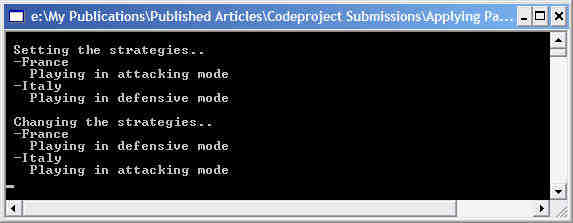
第四部分
Decorator 模式
在这一节我们来讲讲如何应用 Decorator 模式来解决第三个设计问题(如有必要可参考前一篇文章)。这个问题是与球员的运行时职责指派相关的(如前锋、后卫等)。
你可以考虑创建一个球员类,然后基于它派生出类似前锋、中锋和后卫等多个子类。但它并非最好的解决方案,正如我们之前讨论的——一个球员可以在某个时刻是前锋,另一个时刻又变成了中锋。至少,在我们的足球引擎中是这样的,所以这是我们的设计问题。
特定的设计问题:球员拥有额外的职责,如前锋、后卫等,而且可以在运行时切换。
问题泛化:在不使用子类化的情况下,需要能够动态地为对象(在这里是指球员)挂接额外的职责(如前锋、中锋等)。
理解 Decorator 模式
Decorator 模式可以动态地为对象增加职责,是子类化之外的完美之选。下面是 Decorator 模式的 UML 图:
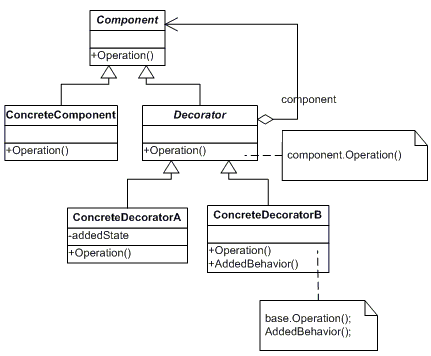
Fig - Decorator Pattern
这个模式由以下部分组成
- 组件(Component)
类 Component 为组件声明了一个抽象接口,我们能够在这些组件上挂接额外的职责。
- 具体的组件(ConcreteComponent)
类 ConcreteComponent 是类 Component 的具体实现,它真正定义了一个能够挂接的额外职责。
- 装饰者(Decorator)
类 Decorator 从类 Component 继承而来,这意味着它继承了组件的所有接口(函数、属性等),而且持有一个从组件类继承下来的对象的引用。其实一个具体的装饰者甚至能够持有其它装饰者的引用(因为类 Decorator 本来就是由类 Component 派生而来)。
- 具体的装饰者(Concrete Decorator)
这个类是真正为组件挂接职责的地方。
应用 Decorator 模式
现在看看如何应用 Decorator 模式来解决与球员相关的设计问题。
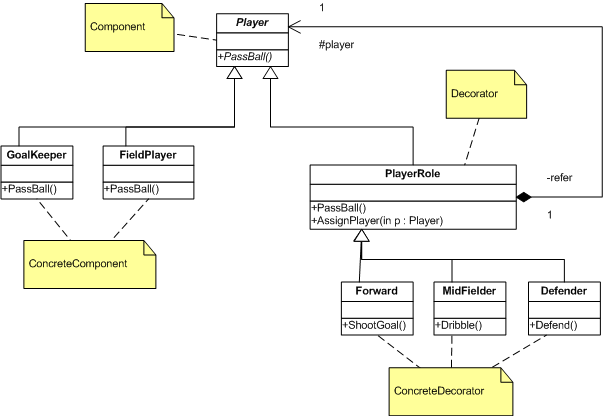
Fig - Solving Our Third Design Problem
可以看到从类 Player 继承两个具体的组件——GoalKeeper 和FieldPlayer,另外还有三个具体的装饰者——Forward、MidFielder和Defender。一个球队有 11 个全场球员和一个守门员(译注:作者写错了,应该是 10个全场球员,后文相同的错误不再指出)。我们的设计问题是需要在运行时指派类似前锋、后卫之类的职责给球员。虽然我们只有 11 全场球员,但可能同时有 11 个前锋和 11 个中锋,因为一个球员可以同时既是前锋又是中锋。通过给球员指派多个角色,和交换它们的角色等,使我们能够规划极佳的比赛策略。
例如可以在比赛的某一时刻通过暂时给一个球员指派 Forward 装饰者,使他可以冲刺和射门。
为具体的组件增加额外的职责,首先可以创建一个具体的组件,然后以引用的形式把它指派给装饰者。比如你可以创建一个全场球员,和一个中锋装饰者,将全场球员指派给中锋装饰者可以为它增加中锋的职责。最后,如果你想,你也可以把同一个球员指派给前锋装饰者。在示例代码中的 GameEngine 模块很好地解释了 Decorator 模式。
下面来看看它的实现,代码都加上了很多注释。
Decorator 模式实现
Player (Component)
类 Player 的实现如下:
' Component: The Player class Public MustInherit Class Player 'Just give a name for this player Private myName As String 'The property to get/set the name Public Property Name() As String Get Return myName End Get Set(ByVal Value As String) myName = Value End Set End Property 'This is the Operation in the component 'and this will be overrided by concrete components Public MustOverride Sub PassBall() End Class ' END CLASS DEFINITION Player
FieldPlayer (ConcreteComponent)
下面是类 FieldPlayer 的实现:
' ConcreteComponent : Field Player class 'This is a concrete component. Later, we will add additional responsibilities 'like Forward, Defender etc to a field player. Public Class FieldPlayer Inherits Player 'Operation: Overrides PassBall operation Public Overrides Sub PassBall () System.Console.WriteLine(_ " Fieldplayer ({0}) - passed the ball", _ MyBase.Name) End Sub 'A constructor to accept the name of the player Public Sub New(ByVal playerName As String) MyBase.Name = playerName End Sub End Class ' END CLASS DEFINITION FieldPlayer
GoalKeeper (ConcreteComponent)
下面是类 GoalKeeper 的实现:
' ConcreteComponent : GaolKeeper class 'This is a concrete component. 'Later, we can add additional responsibilities 'to this class if required. Public Class GoalKeeper Inherits Player 'Operation: Overriding the base class operation Public Overrides Sub PassBall () System.Console.WriteLine(" GoalKeeper " & _ "({0}) - passed the ball", MyBase.Name) End Sub 'A constructor to accept the name of the player Public Sub New(ByVal playerName As String) MyBase.Name = playerName End Sub End Class ' END CLASS DEFINITION GoalKeeper
PlayerRole (Decorator)
下面是类 PlayerRole 的实现:
'Decorator: PlayerRole is the decorator Public Class PlayerRole Inherits player 'The reference to the player Protected player As player 'Call the base component's function Public Overrides Sub PassBall() player.PassBall() End Sub 'This function is used to assign a player to this role Public Sub AssignPlayer(ByVal p As player) 'Keep a reference to the player, to whom this 'role is given player = p End Sub End Class ' END CLASS DEFINITION PlayerRole
Forward (ConcreteDecorator)
下面是类 Forward 的实现:
'ConcreteDecorator: Forward class is a Concrete implementation 'of the PlayerRole (Decorator) class Public Class Forward Inherits PlayerRole 'Added Behavior: This is a responsibility exclusively for the Forward Public Sub ShootGoal() System.Console.WriteLine(" Forward ({0}) - " & _ "Shooted the ball to goalpost", _ MyBase.player.Name) End Sub End Class ' END CLASS DEFINITION Forward
MidFielder (ConcreteDecorator)
下面是类 MidFielder 的实现:
'ConcreteDecorator: MidFielder class is a Concrete implementation 'of the PlayerRole (Decorator) class Public Class MidFielder Inherits PlayerRole 'AddedBehavior: This is a responsibility exclusively for the Midfielder '(Don't ask me whether only mid filders can dribble the ball - atleast 'it is so in our engine) Public Sub Dribble() System.Console.WriteLine(_ " Midfielder ({0}) - dribbled the ball", _ MyBase.player.Name) End Sub End Class ' END CLASS DEFINITION Midfielder
Defender (ConcreteDecorator)
下面是类 Defender 的实现:
'ConcreteDecorator: Defender class is a Concrete implementation 'of the PlayerRole (Decorator) class Public Class Defender Inherits PlayerRole 'Added Behavior: This is a responsibility exclusively for the Defender Public Sub Defend() System.Console.WriteLine(_ " Defender ({0}) - defended the ball", _ MyBase.player.Name) End Sub End Class ' END CLASS DEFINITION Defender
组合起来
'Let us put it together Public Class GameEngine Public Shared Sub Main() '-- Step 1: 'Create few players (concrete components) 'Create few field Players Dim owen As New FieldPlayer("Owen") Dim beck As New FieldPlayer("Beckham") 'Create a goal keeper Dim khan As New GoalKeeper("Khan") '-- Step 2: 'Just make them pass the ball '(during a warm up session ;)) System.Console.WriteLine() System.Console.WriteLine(" > Warm up Session... ") owen.PassBall() beck.PassBall() khan.PassBall() '-- Step 3: Create and assign the responsibilities '(when the match starts) System.Console.WriteLine() System.Console.WriteLine(" > Match is starting.. ") 'Set owen as our first forward Dim forward1 As New Forward() forward1.AssignPlayer(owen) 'Set Beckham as our midfielder Dim midfielder1 As New MidFielder() midfielder1.AssignPlayer(beck) 'Now, use these players to do actions 'specific to their roles 'Owen can pass the ball forward1.PassBall() 'And owen can shoot as well forward1.ShootGoal() 'Beckham can pass ball midfielder1.PassBall() 'Beckham can dribble too midfielder1.Dribble() ' [ Arrange the above operations to some meaningfull sequence, like ' "Beckham dribbled and passed the ball to owen and owen shooted the ' goal ;) - just for some fun ]" '-- Step 4: Now, changing responsibilities '(during a substitution) 'Assume that owen got injured, and we need a new player 'to play as our forward1 System.Console.WriteLine() System.Console.WriteLine(" > OOps, Owen " _ "got injured. " & _ "Jerrard replaced Owen.. ") 'Create a new player Dim jerrard As New FieldPlayer("Jerrard") 'Ask Jerrard to play in position of owen forward1.AssignPlayer(jerrard) forward1.ShootGoal() '-- Step 5: Adding multiple responsibilities '(When a player need to handle multiple roles) 'We already have Beckham as our midfielder. 'Let us ask him to play as an additional forward Dim onemoreForward As New Forward() onemoreForward.AssignPlayer(beck) System.Console.WriteLine() System.Console.WriteLine(" > Beckham has " & _ "multiple responsibilities.. ") 'Now Beckham can shoot onemoreForward.ShootGoal() 'And use his earlier responsibility to dribble too midfielder1.Dribble() 'According to our design, you can attach the responsibility of 'a forward to a goal keeper too, but when you actually 'play football, remember that it is dangerous ;) 'Wait for key press System.Console.Read() End Sub End Class
运行
下面是运行程序的输出
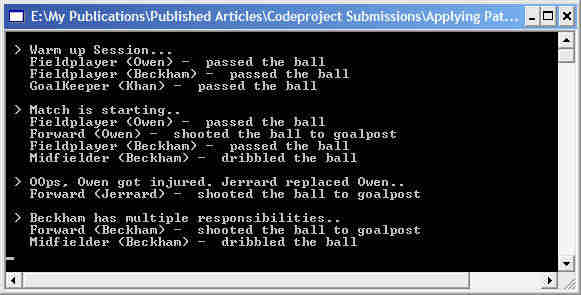
结论
在本文中我们讨论了
- 策略模式及其实现
- 装饰模式及其实现
暂时就这么多了。事实上,正是 code project 社区对我前一篇文章的支持才鼓气我的勇气来发表这一篇。谢谢所有人的支持和鼓励!




 浙公网安备 33010602011771号
浙公网安备 33010602011771号